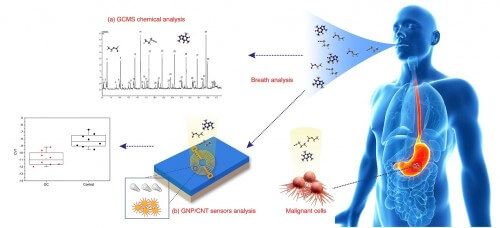The method developed at the Technion allows the detection of people who are in the risk group, as well as the diagnosis of the tumor at the earliest stage. The journal Gut, which reports on the study, notes that it is a cheap, quick, simple and non-invasive test

Technology for the diagnosis of stomach cancer, which was developed at the Technion, allows early diagnosis of the disease as well as locating people who are in the risk group of the disease. The new diagnosis, based on a breath test, has notable advantages over existing diagnostic technologies: it is simple, cheap, fast and non-invasive. This is reported by Gut magazine.
Stomach cancer is one of the deadliest types of cancer, and its development requires in many cases endoscopy diagnoses (which involve fasting, injecting a sedative and inserting a tube through the esophagus) as well as difficult treatments such as chemotherapy, radiation and partial or complete resection of the stomach. The disease develops in several well-defined stages, but today there is no effective, reliable and non-invasive method for diagnosing it in the early stages. Therefore, many people die from the disease simply because they were not diagnosed in time.
The innovative technology, developed by Professor Hussam Haik from the Faculty of Chemical Engineering at the Technion, allows diagnosis of the tumor at the earliest stage - Premalignant Lesion - where the healthy cell begins to turn into a cancerous cell. The research published in Gut, as part of Haitam Amal's doctoral thesis and in collaboration with the research group of Professor Mersis Liga from Latvia, is based on the largest sample in an experiment in this field: 484 subjects, 99 of whom are patients-diagnosed with stomach cancer. Each subject was tested for Helicobacter pylori (a bacterium that is a risk factor for stomach cancer), and two breath samples were taken from him.
The first sample from each subject was analyzed with the GCMS technique, which measures the volatile organic substances in the oral cavity. According to the researchers, GCMS technology is not applicable for diagnosis as it is very expensive and requires long processing processes and a high level of expertise.
The second sample was tested with the unique technology developed by Professor Haik (nanoarray analysis), combined with a pattern recognition algorithm. The findings:
- A. The new technology makes it possible to distinguish, based on the appearance pattern of 8 specific components (out of 130) in the oral cavity, between three groups: patients with stomach cancer, subjects suffering from precancerous tumors (precancerous lesions) in the stomach, and healthy people.
- B. The new technology makes it possible to accurately distinguish between different precancerous stages.
- third. Using the aforementioned technology, it is possible to locate the subjects who are in the risk group for stomach cancer.
- d. The diagnosis is accurate regardless of other factors such as age, sex, smoking, alcohol consumption and use of antacid drugs.
The Nanoarray analysis method developed by Professor Hayek is a precise and sensitive technology, which is a cheap and simple alternative to the existing tests (such as GCMS). This technology will enable early and accurate detection of belonging to a risk group and thus prevent unnecessary invasive tests (endoscopy). In order to evaluate the aforementioned technology as an accurate and applicable diagnostic method, an extensive clinical study is currently underway in Europe, in which thousands of patients suffering from tumors or pre-tumors participate.

11 תגובות
When will it be possible to check it?
By the way, did Hayek also develop new hardware for his patent or did he only create a new algorithm?
You can display illustrations in a larger resolution
Hussam Haik is considered one of the top Israeli scientists with a meteoric rise.
If the Technion had not promoted him, he would have easily been kidnapped by Harvard and such.
His articles receive an enormous amount of citations - thousands, and he received a professorship at a very early age.
For comparison - in the field of POWER, we receive 15 citations per article.
The state knew how to be kind to him and he is benevolent to the state.
The invention is a one-of-a-kind invention, and there is a combination of luck and intelligence.
Thanks
Igal,
Basically what he started with was really lung (a way to detect lung cancer early) and now he's really moved on to other diseases. The body is one unit. Everything you breathe out gives some indication of your state of health at that moment. What does urine have to do with it? What does blood have to do with it? Because everything passes through everything. The waste of the body that comes out through the urine and through the exhalation provides an indication of everything. The trick, of course, is to find what the specific molecules are that will give you that indication of what you're looking for.
What does blowing have to do with the stomach, really?!
Legal: Breath test
I've been reading about Hussam and following his NANOSE since 2006...extremely fascinating. The guy is going to be one of the richest people in the world in the next decade if his breath test does what it promises. By the way, he wants to diagnose a large number of diseases through the breath test. He wanted to bring it to market as early as 2014, now he says it will be out by 2020 or so.
Is there any clinical research in Israel and in which hospital and how can one participate in this type of clinical research. Blessings for your work with your team for all of humanity
I didn't understand in the end how the new test is actually done